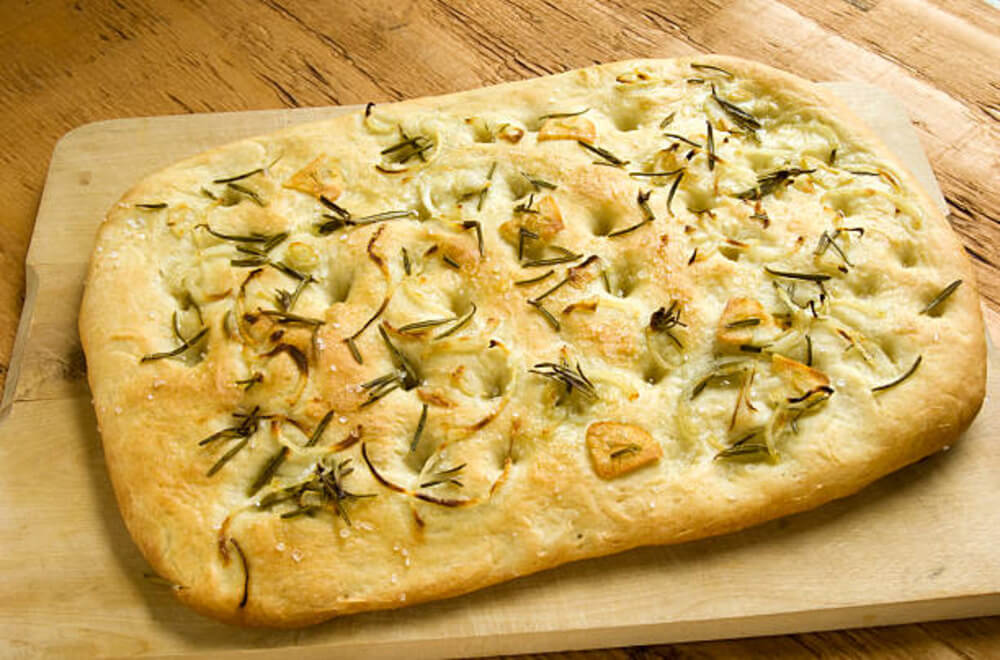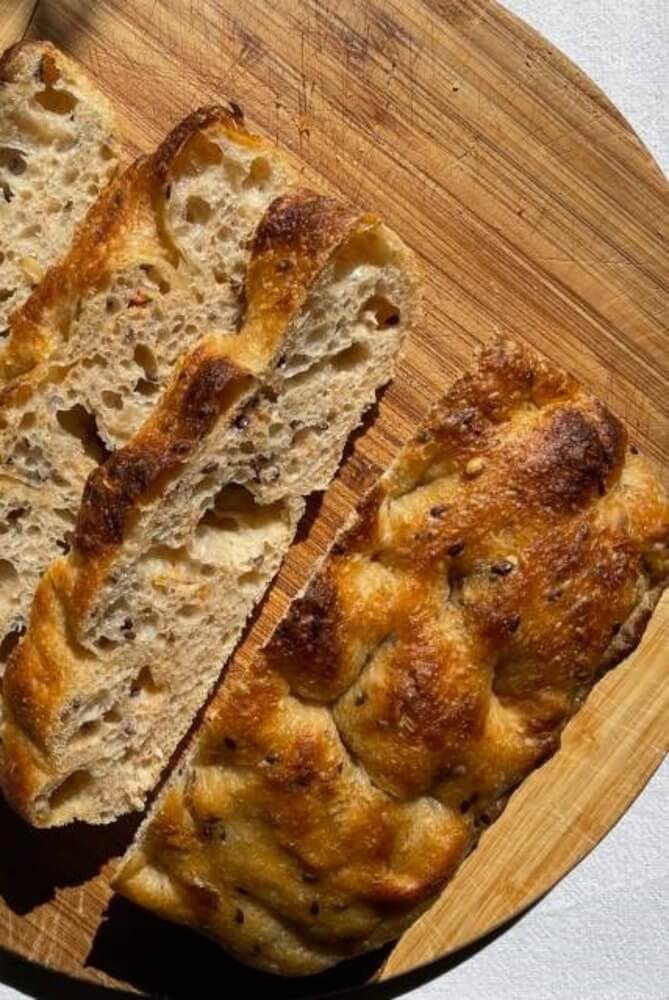Sourdough Focaccia Recipe
Sourdough focaccia is a delightful combination of the chewy, tangy characteristics of sourdough and the airy, olive oil-laden texture of traditional focaccia. This unique bread is a favorite among bread enthusiasts, offering a satisfying bake with a complex flavor profile. The process of making focaccia from scratch not only fills your kitchen with an irresistible aroma but also provides a sense of accomplishment and connection to ancient baking traditions.

Ingredients Breakdown
For this recipe, you will need a precise selection of ingredients:
600 g bread flour: The backbone of your focaccia, bread flour gives the dough its structure and strength.
450 g warm water: Hydration is key in focaccia, and warm water helps activate the sourdough starter.
180 g sourdough starter: This natural leavening agent provides the distinctive tang and contributes to the airy crumb.
13 g fine sea salt: Enhances the flavor and strengthens the dough structure.
Fresh rosemary and whole garlic cloves (in their skins): Classic focaccia toppings that infuse the bread with aromatic flavors.
When sourcing your ingredients, opt for high-quality bread flour, fresh rosemary, and garlic. The freshness of your ingredients significantly impacts the final taste and texture.
Step-by-Step Instructions
Preparing the Sourdough Starter
Feed your sourdough starter in the morning. This ensures you have 180g ready for the recipe, with extra to keep your starter thriving. The starter should double in size within 4-5 hours, depending on the temperature of your kitchen. A well-fed starter is crucial for achieving the right rise and flavor in your focaccia.
Mixing the Dough
Combine the flour and water in a stand mixer fitted with a bread hook. Gradually drizzle in the warm water while the machine runs on low speed. Mix for just 1-2 minutes, aiming for a shaggy dough that holds together but still looks rough. This initial mix hydrates the flour, setting the stage for gluten development.
Initial Dough Rest
Cover the bowl with a clean towel and let the dough rest for 30 minutes. This autolyse period allows the flour to fully absorb the water, making the dough easier to work with and enhancing the final texture.
Incorporating the Starter and Salt
Add the sourdough starter to the dough and mix on low speed. Slowly incorporate the fine sea salt, ensuring even distribution. Mix for another 2-3 minutes until the starter is fully integrated. The dough will be sticky, which is normal for focaccia.
Folding Technique
Leave the dough in the mixer bowl or transfer it to a clean bowl. Perform a series of envelope folds every 20 minutes. Stretch and fold the dough over itself, rotating the bowl each time. Cover and rest the dough between folds. Repeat this routine three times, completing a total of 12 folds. This technique builds dough strength and structure without overworking it.
Overnight Fermentation
Let the dough rise until it doubles in size and passes the windowpane test. Cover the bowl tightly with plastic wrap and refrigerate overnight. This slow fermentation enhances the flavor and texture, resulting in a more complex and satisfying bread.
Shaping and Final Rise
In the morning, grease your baking pan with 1-2 tablespoons of olive oil. Gently turn the dough out into the pan and stretch it in an up-and-down motion a few times. Allow the dough to rest at room temperature for 3-4 hours until it doubles in size again and has a jiggly consistency.
Baking the Focaccia
Preheat your oven to 425℉. Drizzle a generous amount of olive oil over the top of the dough. With oiled hands, create dimples in the dough by pressing down with your fingers. Sprinkle fresh rosemary, whole garlic cloves, and optionally, a pinch of coarse sea salt over the top. Bake for 23-30 minutes, adjusting the time based on your pan size, until the focaccia achieves a golden brown crust.
Recipe Tips & Frequently Asked Questions
Tips for achieving the best results:
Use a well-maintained starter for optimal rise.
Be patient during the fermentation stages.
Adjust water content slightly if your dough seems too dry or wet.
Common pitfalls and how to avoid them:
Over-mixing can result in a tough dough. Mix only until combined.
Insufficient fermentation time leads to dense bread. Ensure the dough doubles in size.
Suggestions for experimenting with different toppings:
Try adding sun-dried tomatoes, olives, or caramelized onions.
Experiment with different herbs like thyme or oregano.
Common questions about sourdough focaccia:
Why is my dough not rising? Check the activity of your starter and room temperature.
Can I use all-purpose flour instead of bread flour? Bread flour is recommended for its higher protein content, but all-purpose can be used with slight texture differences.
Troubleshooting tips for common issues:
If your dough is too sticky, use wet hands to handle it.
For a crispier crust, bake a few minutes longer and check frequently.
Additional advice for beginners and advanced bakers:
Beginners should follow the recipe closely before experimenting.
Advanced bakers can try incorporating different fermentation techniques or flavors.
What to Serve with This Recipe
Sourdough focaccia is incredibly versatile. Serve it alongside a hearty soup or salad, or use it to make gourmet sandwiches. It pairs wonderfully with cheese boards, charcuterie, and a glass of wine. Its rich, aromatic flavor complements a variety of dishes, making it a great addition to any meal.
Storage and Reheating
Store leftover focaccia in an airtight container at room temperature for up to two days. For longer storage, freeze the focaccia wrapped in foil and a freezer bag for up to three months. To reheat, wrap the bread in foil and warm it in a 350℉ oven until heated through. This method helps retain the bread’s texture and flavor.
Sourdough focaccia is a delightful and rewarding bread to bake. Its unique texture and flavor make it a standout addition to any meal. By following this detailed guide, you can achieve a perfect loaf every time. Enjoy the process, and don’t be afraid to experiment with different toppings and flavors. Happy baking!

INGREDIENTS:
600 g bread flour
450 g warm water
180 g sourdough starter
13 g fine sea salt
Focaccia Toppings
Fresh rosemary
Whole garlic cloves (in their skins)
INSTRUCTIONS:
Start by feeding your sourdough starter in the morning so that you have 180g ready for this recipe, plus some extra to keep it going.
When the starter has doubled in size, usually within 4-5 hours depending on the ambient temperature, combine the flour and water. Add 600g of flour to the bowl of a stand mixer fitted with the bread hook attachment. While the machine is running on low speed, gradually drizzle in 450g of warm water. Mix for just 1-2 minutes until the dough comes together, though it should still look a bit rough.
Cover the bowl with a clean towel and let the dough rest for 30 minutes.
After this initial rest, add the sourdough starter to the dough. Mix on low speed to combine, then slowly add the 13g of fine sea salt. Continue mixing on low for another 2-3 minutes until the starter is fully incorporated into the dough, which will be quite sticky at this stage.
You can leave the dough in the stand mixer bowl or transfer it to a clean bowl. Perform a series of envelope folds every 20 minutes: take one side of the dough with both hands, stretch it up and fold it over to the other side, rotate the bowl 25 degrees, and repeat this process four times. Cover and let the dough rest between each set of folds. Do this folding routine three times in total, resulting in 12 folds.
Cover the dough and let it rise until it has doubled in size and passes the windowpane test. At this point, cover the bowl tightly with plastic wrap and refrigerate overnight.
In the morning, remove the dough from the fridge. Grease your baking pan with 1-2 tablespoons of olive oil. Gently turn the dough out into the pan and, using both hands, stretch it in an up-and-down motion a few times. Don’t worry if it doesn’t fully reach the edges of the pan yet.
Allow the dough to rest at room temperature for 3-4 hours.
Once the dough has doubled in size again and has a slightly jiggly consistency, preheat your oven to 425℉.
When the oven is ready, drizzle a generous amount of olive oil over the top of the focaccia. With oiled hands, create dimples in the dough by pressing down with your fingers. Sprinkle fresh rosemary, whole garlic cloves (still in their skins), and optionally, a generous pinch of coarse sea salt over the top.
Bake the focaccia for 23-30 minutes, adjusting the time based on your pan size (closer to 30 minutes for a 9×13 pan versus slightly less for a 10×14 pan) until it achieves a golden brown crust.
Allow the focaccia to cool for 30 minutes before slicing and serving.

Sourdough Focaccia Recipe
Ingredients
- 600 g bread flour
- 450 g warm water
- 180 g sourdough starter
- 13 g fine sea salt
- Focaccia Toppings
- Fresh rosemary
- Whole garlic cloves in their skins
Instructions
- Start by feeding your sourdough starter in the morning so that you have 180g ready for this recipe, plus some extra to keep it going.
- When the starter has doubled in size, usually within 4-5 hours depending on the ambient temperature, combine the flour and water. Add 600g of flour to the bowl of a stand mixer fitted with the bread hook attachment. While the machine is running on low speed, gradually drizzle in 450g of warm water. Mix for just 1-2 minutes until the dough comes together, though it should still look a bit rough.
- Cover the bowl with a clean towel and let the dough rest for 30 minutes.
- After this initial rest, add the sourdough starter to the dough. Mix on low speed to combine, then slowly add the 13g of fine sea salt. Continue mixing on low for another 2-3 minutes until the starter is fully incorporated into the dough, which will be quite sticky at this stage.
- You can leave the dough in the stand mixer bowl or transfer it to a clean bowl. Perform a series of envelope folds every 20 minutes: take one side of the dough with both hands, stretch it up and fold it over to the other side, rotate the bowl 25 degrees, and repeat this process four times. Cover and let the dough rest between each set of folds. Do this folding routine three times in total, resulting in 12 folds.
- Cover the dough and let it rise until it has doubled in size and passes the windowpane test. At this point, cover the bowl tightly with plastic wrap and refrigerate overnight.
- In the morning, remove the dough from the fridge. Grease your baking pan with 1-2 tablespoons of olive oil. Gently turn the dough out into the pan and, using both hands, stretch it in an up-and-down motion a few times. Don’t worry if it doesn’t fully reach the edges of the pan yet.
- Allow the dough to rest at room temperature for 3-4 hours.
- Once the dough has doubled in size again and has a slightly jiggly consistency, preheat your oven to 425℉.
- When the oven is ready, drizzle a generous amount of olive oil over the top of the focaccia. With oiled hands, create dimples in the dough by pressing down with your fingers. Sprinkle fresh rosemary, whole garlic cloves (still in their skins), and optionally, a generous pinch of coarse sea salt over the top.
- Bake the focaccia for 23-30 minutes, adjusting the time based on your pan size (closer to 30 minutes for a 9×13 pan versus slightly less for a 10×14 pan) until it achieves a golden brown crust.
- Allow the focaccia to cool for 30 minutes before slicing and serving.

